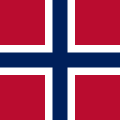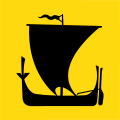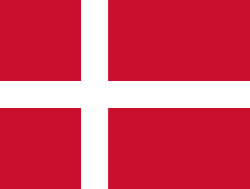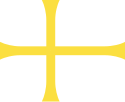Norská vlajka
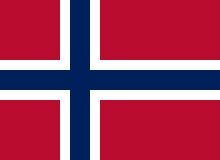

 Norská národní vlajka
Norská národní vlajkaPoměr stran: 8:11


 Norská státní a válečná vlajka
Norská státní a válečná vlajkaPoměr stran: 16:27
Vlajka Norska je červená s tmavě modrým heroldským skandinávským křížem, jenž je bíle orámován, přičemž kříž i orámování sahají až k okrajům.[1]
Kratší rameno, tak jak je tomu u skandinávského kříže zvykem, je posunuto směrem k žerďovému lemu listu. Norská vlajka je založena na Dannebrogu, dánské vlajce.
- Vlajka norského krále
Poměr stran: 5:7 - Norská lodní vlajka (Naval Jack)
Poměr stran: 1:1
Popis
Národní vlajka
Norská národní vlajka je tvořena obdélníkovým listem o poměru 8:11. Její barevné elementy jsou na šířku v poměrech 6:1:2:1:6 (červená:bílá:modrá:bílá:červená) a na délku 6:1:2:1:12 (červená:bílá:modrá:bílá:červená).
Státní vlajka
Norská státní a válečná vlajka má podobu obdélníku zakončeného třemi plameny. Poměr stran státní vlajky je 16:27 a její barevné elementy jsou na šířku v poměrech 6:1:2:1:6 (červená:bílá:modrá:bílá:červená) a na délku 6:1:2:1:6:11 (červená:bílá:modrá:bílá:červená).
Barvy
Červená by měla být PMS 200 a modrá PMS 281 v barevném systému Pantone,[2] což přibližně odpovídá v RGB systému barev hodnotám #BA0C2F (červená),[3] #00205B (modrá)[4] a #FFFFFF (bílá).
- Rozměry norské vlajky
- Rozměry norské státní a válečné vlajky
Historie
Od 16. století do roku 1814 Norsko užívalo dánskou vlajku, během krátkého osamostatnění a stejně krátkého panování Kristiána Friderika v roce 1814 byla navržena na Dannebrogu založená vlajka, která měla v levém horním poli norského lva. Tato vlajka se užívala až do roku 1821.
Od roku 1814 bylo Norsko připojeno ke Švédsku, roku 1815 byla přijata pro Norsko žlutomodrá švédská vlajka, v jejímž levém horním poli byl bílý ondřejský kříž na červeném poli. Tato vlajka byla přijata jako vládní vlajka a vlajka pro obchodní lodi plující za mys Finisterre, ta byla užívána až do roku 1838, neboť Norsko nemělo smlouvu s piráty ze Severní Afriky. Osobitá a dnes známá norská vlajka byla navržena roku 1821 Fredrikem Meltzerem, jenž byl členem norského parlamentu (Storting). Barvy byly zvoleny po vzoru francouzské revoluční trikolóry.
Roku 1844 byl do levého horního pole norské vlajky umístěn symbol norsko-švédské unie. Symbolu se říkalo Sildesalaten – „sleďový salát“, protože salát připomínal.
Zpočátku byl znak norsko-švédské unie oblíben, protože ukazoval rovnost postavení, nicméně svazek se Švédskem byl stále více neoblíbený a norský parlament zrušil unijní znak roku 1899 na obchodní i státní vlajce.
Po osamostatnění v roce 1905 byl znak norsko-švédské unie zrušen i na vlajkách námořnictva, přičemž si ho Švédsko podrželo na všech vlajkách také až do roku 1905.
 Vlajka Dánsko-Norské unie
Vlajka Dánsko-Norské unie Norská vlajka užívaná od roku 1844
Norská vlajka užívaná od roku 1844 Symbol Norsko-Švédské unie: Sildesalaten – „sleďový salát“
Symbol Norsko-Švédské unie: Sildesalaten – „sleďový salát“
Vlajky norských krajů

Norsko je od 1. ledna 2024 členěno na 15 krajů (norsky fylke, pl. fylker), do roku 1918 známých jako amt, pl. amter.
Před rokem 1972 krajů bylo 20 (existoval ještě kraj Bergen), v letech 1972–2017 jich bylo 19, v letech 2018–2019 bylo krajů 18 (byly sloučeny kraje Nord-Trøndelag a Sør-Trøndelag do jednoho kraje Trøndelag). V letech 2020–2023 jich bylo 11. Hlavní město Oslo je považováno za kraj i za samosprávné město.[5]
- Hlavni město Oslo
Poměr stran: 8:11
- Akershus
Poměr stran: 17:21 - Agder
Poměr stran: 2:3 - Buskerud (6)
Poměr stran: ~1:1 - Finnmark
Poměr stran: 1:1 - Møre a Romsdal
Poměr stran: 5:8 - Nordland
Poměr stran: 1:1 - Rogaland (od roku 1974)
Poměr stran: 4:5 - Telemark (od roku 1970)
Poměr stran: 6:5 (ve zdroji jiný) - Troms
Poměr stran: 5:8 - Trøndelag
Poměr stran: 5:8 - Vestfold
Poměr stran: 8:11 - Østfold
Poměr stran: 1:1
- Zaniklé kraje
Chybí obrázky vlajek:
- Troms a Finnmark (2020–2023)
- Viken (2020–2023)
- Měso Bergen, do roku 1972 kraj
Poměr stran: 2:3 (zobrazeno)
- Zámořská teritoria
Norsko má také dvě zámořská teritoria, ostrovy Jan Mayen a Špicberky. Dále má tři antarktická a subantarktická závislá území: Bouvetův ostrov, Ostrov Petra I. a Zemi královny Maud. Na těchto územích se užívá norská vlajka.
Odkazy
Reference
- ↑ Norská vlajka na Flags of the World
- ↑ The Norwegian flag | Nordic cooperation
- ↑ PANTONE® 200 C - Find a Pantone Color | Quick Online Color Tool | Pantone. www.pantone.com [online]. [cit. 2021-04-10]. Dostupné v archivu pořízeném z originálu dne 2021-07-16.
- ↑ PANTONE® 281 C - Find a Pantone Color | Quick Online Color Tool | Pantone. www.pantone.com [online]. [cit. 2021-04-10]. Dostupné v archivu pořízeném z originálu dne 2021-07-16.
- ↑ Vlajky norských krajů na Flags of the World
Literatura
- Hroch M. a kolektiv: Dějiny Norska. Nakladatelství Lidové Noviny, Praha, 2005. 1. vyd. 340 s. ISBN 80-7106-407-6
- Frajdl, J., Zálabský, J.: Vexilologie. Pedagogická fakulta Hradec Králové, Ústřední politická škola SSM Seč, Seč, 1983. 1. vyd. 127 s.
Související články
Externí odkazy
 Obrázky, zvuky či videa k tématu norská vlajka na Wikimedia Commons
Obrázky, zvuky či videa k tématu norská vlajka na Wikimedia Commons - Norské vlajky v průběhu dějin (norsky)
- Historie norské vlajky na Stortinget.no (norsky)
- Přehled vlajek Norska na Riksarkivet.no (norsky)
Média použitá na této stránce
Autor: DoktorMandrake, Licence: CC BY-SA 3.0
IFIS for "historical version" (not part of original set of symbols)
Zástupný symbol vlajky. Vizte též Category:Flag placeholders a Coats of arms of None.svg.
Autor: Tijmen Stam (User:IIVQ), Licence: CC BY 2.5
Vexillological symbol according to FIAV / W. Smith
This symbol in particular means that the flag is the current and official flag of the group or nation.
Autor: TheSecretPower, Licence: CC BY-SA 4.0
Flag of Agder County, Norway. "A golden oak tree on a red field." Based on the former flags of Aust-Agder and Vest-Agder, using Vest-Agder's motif with Aust-Agder's color scheme.
Autor:
Hallvard Trætteberg, vectorization by VulpesVulpes42
The flag of the county of Vestfold, Norway. Its design is shared with the county arms, and shows a mediaeval style royal crown, representing Vestfold's special connection to Norway's oldest royal dynasty. Harald Fairhair, from which Norwegian kings in the following centuries claimed to have descended, belonged to the Yngling dynasty, which ruled Vestfold when it was its own kingdom in the 9th century. The flag was approved by royal resolution 1970‐01‐30.
Autor:
Hallvard Trætteberg, vectorization by VulpesVulpes42
⸻
(Authorship information for the oldest file version:)
Coat of arms by Fleinn (PD-Norwegian CoA)
SVG flag by SiBr4, Licence: CC BY-SA 3.0
The flag of the county of Finnmark, Norway. Its design is shared with the county arms, and shows a castle as a heraldic representation of Vardøhus Fortress, Norway’s eastern border fortification against Russia, originally erected in the early 14th century by King Haakon V. More broadly, it also stands for Norwegian sovereignty over the county. By the time the design was officially approved, Norway was well into the post‐war era, and the castle came to be seen as a powerful symbol of the rebuilding of Finnmark. The flag was approved by royal resolution 1967‐01‐06.
The flag of the former county of Hordaland, Norway. Its design is shared with the county arms, and consists of a crown above two crossed axes. This motif originates from a seal, that of the guild of Saint Olaf at Onarheim, which was used on behalf of Sunnhordland district on a royal letter of proclamation from 1344. The axe is the aforesaid saint's instrument of martyrdom. While it is unknown what tinctures the arms would have had in the Middle Ages, the red and gold of the modern resurrection harmonize with the national arms.
As early as in 1918, the question of county arms had been considered by the county council—nothing initially came out of this, and it would last until 1949 before the council decided that Hordaland had to get arms of its own. Getting the design approved by the Norwegian government would however prove to be a drawn‐out process lasting 12 years. Medieval coinage would feature one or two axes as a royal emblem, and as such, the National Archives entertained the idea of reserving the Onarheim seal as secondary national arms. This ultimately led nowhere, and so, on December 1st, 1961, arms based upon the old seal and a corresponding flag were finally approved for Hordaland by royal resolution.
The unofficial flag of Oslo 1924–2000
Autor: PNG flag by AlexR.L. (CC-BY-SA 3.0)
Coat of arms by Havarhen (PD-Norwegian CoA)
SVG flag by SiBr4, Licence: CC BY-SA 3.0
Flag of Troms County, Norway.
The flag of the former county of Aust‐Agder, Norway. Its design is shared with the county arms, and consists of two bars. This heraldic ordinary is known as "bjelke" in Norwegian, which outside heraldic contexts has a meaning of "beam". Of great economic importance to the county have been the extraction of iron ore and the harvesting of timber, including beams used for shipbuilding or exporting to the rest of Europe. In addition, the two bars represent the inland and coastal districts.
The flag was approved by royal resolution 1958‐12‐12, following decisions by the county council (1958‐04‐18) and the county executive board (1958‐10‐16).
Naval jack for the union between Sweden and Norway, as well as the diplomatic flag of the union with the proportions 5:4.
The flag of the former county of Vestfold and Telemark, Norway, which existed between 2020 and 2023.
Autor: PNG flag by AlexR.L. (CC-BY-SA 3.0)
Coat of arms by SKvalen (PD-Norwegian CoA)
SVG flag by SiBr4, Licence: CC BY-SA 3.0
Flag of Nord-Trøndelag County, Norway.
Autor:
Hallvard Trætteberg, vectorization by VulpesVulpes42
⸻
(Authorship information for the oldest file version:)
Coat of arms by SKvalen (PD-Norwegian CoA)
SVG flag by SiBr4, Licence: CC BY-SA 3.0
The flag of the former county of Buskerud, Norway. Its design is shared with the county arms, and shows a blue bear, constituting an expression of Buskerud's vast expanses of mountains and forests, among which Vassfaret in particular has been known for its populations of bears. The ursine's striking colouration is a reference to the Blue Colour Works in Modum, where cobalt ore was mined, and blue pigment produced from it. For a time, the works were the largest of their kind in the world—the fruits therefrom once made up 80% of the global market, and constituted a pertinent export.
The white background of the flag carries symbolism too. Within heraldry, it is permissible to use white to depict silver, and on flags, this is even customary. Here, a white/silver background is used to represent the Kongsberg Silver Mines, and their massive mineral riches—operating between 1623 and 1957, their history spanned over 300 years. The flag was approved by royal resolution 1966‐04‐01.
Autor:
Hallvard Trætteberg, vectorization by VulpesVulpes42
⸻
(Authorship information for the oldest file version:)
Coat of arms by SKvalen (PD-Norwegian CoA)
SVG flag by SiBr4, Licence: CC BY-SA 3.0
The flag of the county of Østfold, Norway. Its design is shared with the county arms, and shows a sunbeam, which makes two different links symbolically. Firstly, as the sun rises in the east, it refers to the name and geographic location of the county ("øst" means east in Norwegian). Secondly, the solar design alludes to the fertility worship expressed in the numerous Bronze Age petroglyphs found in Østfold. In heraldry, the rays of the sun are often depicted as alternatingly straight and wavy, with the straight rays being said to represent light, and the wavy ones heat. The flag was approved by royal resolution 1958‐09‐26.
Flag of Oslo, Norway. This flag was created to the city anniversary in 2000 and is not approved by the Norwegian government. (Engene, Jan Oskar; "Nytt byflagg for Oslo? Noen kommentarer til tusenårsjubilantens 'særpregete' nye flagg." Nordisk Flaggkontakt 3-2000 pp. 31-33.)
Autor: Uwe Dedering, Licence: CC BY-SA 3.0
Flag of the norwegian county Nordland
Autor: No machine-readable author provided. Hosmich assumed (based on copyright claims)., Licence: CC BY-SA 3.0
Royal Standard of Norway 1905, design by Eilif Peterssen
The state flag of Norway. (See also the image of the national flag of Norway.)
The proportions of the state flag are 27:16, or 6:1:2:1:6:11 horizontally and 6:1:2:1:6 vertically.Map showing the 15 counties of Norway as of January 1st 2024.
The official flag of the city of Bergen.
"The flag is white with a red border on three sides and the city arms centred on the cloth. The red colour shall be the same as in the Norwegian flag. Proportions: White cloth, height 9 parts, width 12 parts. Red border on three sides 1 part. Distance between shield and upper and lower edge is 2 parts." (Profile manual of the city of Bergen)
Autor: PNG flag by AlexR.L. (CC-BY-SA 3.0)
Coat of arms by SKvalen (PD-Norwegian CoA)
SVG flag by SiBr4, Licence: CC BY-SA 3.0
Flag of Sør-Trøndelag County, Norway.
This is merely a recreation of what the flag is thought to have looked like. There are no surviving flags or pictorial evidence as to its appearance. See article at Flags of the World.
Autor: Doktor Mandrake, Licence: CC BY-SA 3.0
IFIS for "reconstruction based on past observations"
Flag of Norway In 1844 a union badge combining Norwegian and Swedish colors was placed at the hoist of both countries' flags. The badge was popularly called Sildesalaten ("the herring salad") from its resemblance to a herring salad. Initially, the union flag was popular in Norway, since it clearly denoted the equal status of the two united states. But as the union with Sweden became increasingly less popular, the Norwegian parliament abolished the union badge from the national (merchant) and state flags in 1899. At the dissolution of the union in 1905, the badge was removed from the navy flag as well. Sweden kept it in all flags until 1905.
Autor:
Truls Nygaard, vectorization by VulpesVulpes42
⸻
(Authorship information for the oldest file version:)
Coat of arms by SKvalen (PD-Norwegian CoA)
SVG flag by SiBr4, Licence: CC BY-SA 3.0
The flag of the former county of Hedmark, Norway. Its design is shared with the county arms, and shows three bark spuds. An innovative heraldic charge, it is well suited to represent forestry, befitting Hedmark's status as Norway's largest forest county. The triad of spuds can addedly stand for the three traditional regions of Østerdalen, Solør‐Odal, and Hedmarken. The flag was decided upon by the county executive board 1986‐12‐16, and approved by royal resolution 1987‐02‐06.
Autor: Finn Fagerli, vectorization by Gunnar Offel, Licence: CC BY-SA 3.0
The flag of the county of Akershus, Norway. Its design is shared with the county arms, and shows a stepped gable, suggestive of the silhouette of Akershus Castle. It is from this fortress that the county as a geographical area (as well as several historical administrative entities in Norway) gets its name. By extension, the motif alludes to the centuries‐old connection between the castle and its environing districts. The flag was decided upon by the county executive board 1987‐05‐05, and approved by royal resolution 1987‐12‐11.
Flag of Norway — construction sheet
Flag of Sogn og Fjordane, Norway.
Autor: PNG flag by AlexR.L. (CC-BY-SA 3.0)
Coat of arms by SKvalen (PD-Norwegian CoA)
SVG flag by SiBr4, Licence: CC BY-SA 3.0
Flag of Telemark County, Norway.
Autor: PNG flag by AlexR.L. (CC-BY-SA 3.0)
Coat of arms by Knowledgeisfree (PD-Norwegian CoA)
SVG flag by SiBr4, Licence: CC BY-SA 3.0
Flag of Møre og Romsdal County, Norway.
Flag of Norway — state and war + naval ensign — construction sheet
The flag of the former county of Oppland, Norway. Its design is shared with the county arms, and shows a spring pasqueflower. This distinctive plant is prevalent in the mountainous parts of Oppland, a county with 80% of its area situated above 600 m.a.s.l. The lush, lower‐lying parts of the county are included by the green background. Oppland's traditional districts are represented by the different parts of the plant: the two flowers stand for the Valdres and Gudbrand valleys, while the three leaves stand for the lowland districts of Land, Hadeland, and Toten. The flag was decided upon by the county council 1989‐03‐13, and approved by royal resolution 1989‐06‐23.
Autor:
Hallvard Trætteberg, vectorization by VulpesVulpes42
⸻
(Authorship information for the oldest file version:)
Coat of arms by SKvalen (PD-Norwegian CoA)
SVG flag by SiBr4, Licence: CC BY-SA 3.0
The flag of the county of Rogaland, Norway. Its design is shared with the county arms, and depicts a heraldic abstraction of a stone cross, now in the Stavanger Museum, commemorating Erling Skjalgsson (d. 1028). The point at the cross’s foot enabled it to be staked into the ground or affixed to a processional staff. The flag was approved by royal resolution 1974‐01‐11.
